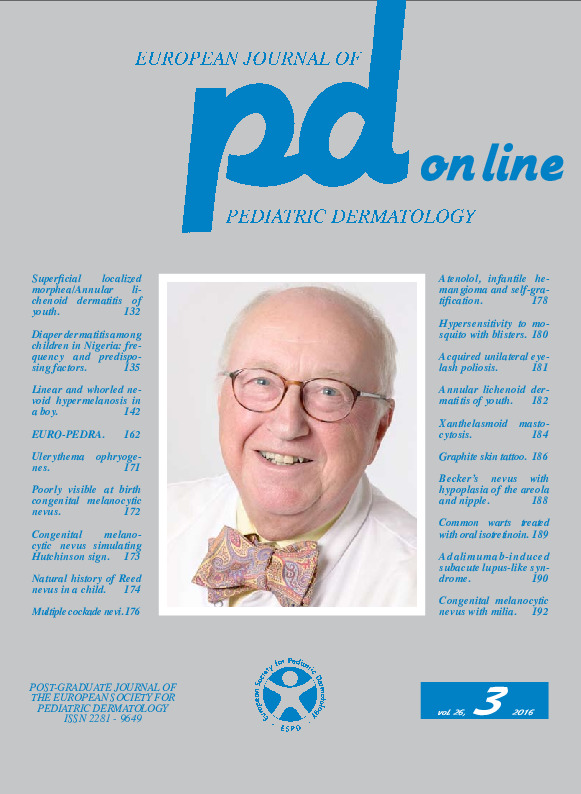Natural history of Reed nevus in a child. A 5-year follow up.
Downloads
DOI:
https://doi.org/10.26326/2281-9649.26.3.1258How to Cite
Bonifazi E., Milano A., Tarantino G. 2016. Natural history of Reed nevus in a child. A 5-year follow up. Eur. J. Pediat. Dermatol. 26 (3):174-5. 10.26326/2281-9649.26.3.1258.
pp. 174-5
Abstract
The diagnosis, prognosis and therapy of a cutaneous proliferation of melanocytes first observed due to its rapid growth are strongly influenced by the age of the subject (14): in the child it is almost always a nevus, in adults it is very often a melanoma. This dilemma did not exist until 1948: until then any fast-growing melanocytic proliferation was a melanoma regardless of the age. In 1948 Spitz (12) sensed that the melanocytic proliferations in the child had a better prognosis and the following year Allen (1) declassified juvenile melanoma to the role of nevus, which is rightly known today under the name of Spitz nevus (SN). However, the memory of the previous situation is not entirely disappeared and still today dermatologists who do not see many children (13) deal with Spitz nevus as if it was a melanoma; therefore, the natural history of SN is little known because usually SN is removed.The natural history of SN, which is well-known by pediatric dermatologists, shows an initial growth phase lasting 6-12 months, followed by a phase of involution, like so many other childhood proliferations, from infantile hemangioma to juvenile xanthogranuloma and mastocytoma. This natural history is observed both in the non-pigmented, angioma-like variant and in the pigmented SN that in the child have a similar frequency; the pigmented variant of SN is indistinguishable from Reed nevus (11) based on clinical or dermoscopic and sometimes even histological findings, so that some Authors (8) speak of Spitz-Reed nevus. The non-pigmented variant of SN, which is usually palpable in the form of plaque or nodule, in the involution phase may undergo a complete clinical regression with mild atrophy or become a common pigmented melanocytic nevus (4); the pigmented variant, usually junctional or plaque, in the involution phase tends to flatten when palpable or, when junctional, to take on a more regular profile with loss of pseudopods, which are clinically visible in the growth phase, and reduced pigmentation (2, 3, 6, 7, 10, 13). (...)
Keywords
Spitz nevus, Reed nevus

